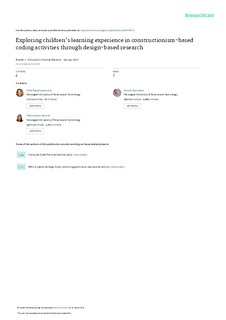| dc.contributor.author | Papavlasopoulou, Sofia | |
| dc.contributor.author | Giannakos, Michail | |
| dc.contributor.author | Jaccheri, Maria Letizia | |
| dc.date.accessioned | 2019-04-24T10:44:39Z | |
| dc.date.available | 2019-04-24T10:44:39Z | |
| dc.date.created | 2019-01-20T21:32:33Z | |
| dc.date.issued | 2019 | |
| dc.identifier.issn | 0747-5632 | |
| dc.identifier.uri | http://hdl.handle.net/11250/2595249 | |
| dc.description.abstract | Over the last few years, the integration of coding activities for children in K-12 education has flourished. In addition, novel technological tools and programming environments have offered new opportunities and increased the need to design effective learning experiences. This paper presents a design-based research (DBR) approach conducted over two years, based on constructionism-based coding experiences for children, following the four stages of DBR. Three iterations (cycles) were designed and examined in total, with participants aged 8–17 years old, using mixed methods. Over the two years, we conducted workshops in which students used a block-based programming environment (i.e., Scratch) and collaboratively created a socially meaningful artifact (i.e., a game). The study identifies nine design principles that can help us to achieve higher engagement during the coding activity. Moreover, positive attitudes and high motivation were found to result in the better management of cognitive load. Our contribution lies in the theoretical grounding of the results in constructionism and the emerging design principles. In this way, we provide both theoretical and practical evidence of the value of constructionism-based coding activities. | nb_NO |
| dc.language.iso | eng | nb_NO |
| dc.publisher | Elsevier | nb_NO |
| dc.rights | Attribution-NonCommercial-NoDerivatives 4.0 Internasjonal | * |
| dc.rights.uri | http://creativecommons.org/licenses/by-nc-nd/4.0/deed.no | * |
| dc.title | Exploring children’s learning experience in constructionism-based coding activities through design-based research | nb_NO |
| dc.type | Journal article | nb_NO |
| dc.type | Peer reviewed | nb_NO |
| dc.description.version | acceptedVersion | nb_NO |
| dc.source.journal | Computers in Human Behavior | nb_NO |
| dc.identifier.doi | 10.1016/j.chb.2019.01.008 | |
| dc.identifier.cristin | 1661590 | |
| dc.relation.project | Norges forskningsråd: 255129 | nb_NO |
| dc.relation.project | EC/H2020/787476 | nb_NO |
| dc.description.localcode | © 2018. This is the authors’ accepted and refereed manuscript to the article. Locked until 16.1.2021 due to copyright restrictions. This manuscript version is made available under the CC-BY-NC-ND 4.0 license http://creativecommons.org/licenses/by-nc-nd/4.0/ | nb_NO |
| cristin.unitcode | 194,63,10,0 | |
| cristin.unitname | Institutt for datateknologi og informatikk | |
| cristin.ispublished | true | |
| cristin.fulltext | postprint | |
| cristin.qualitycode | 1 | |

